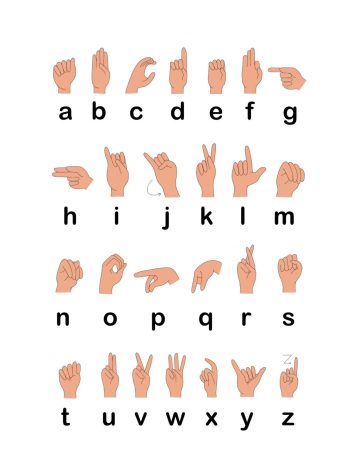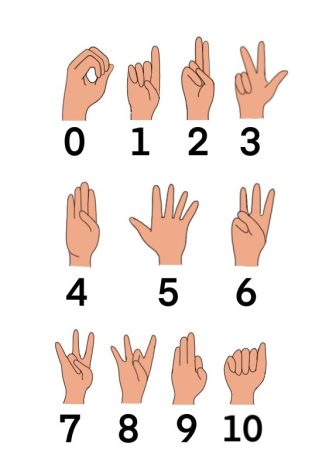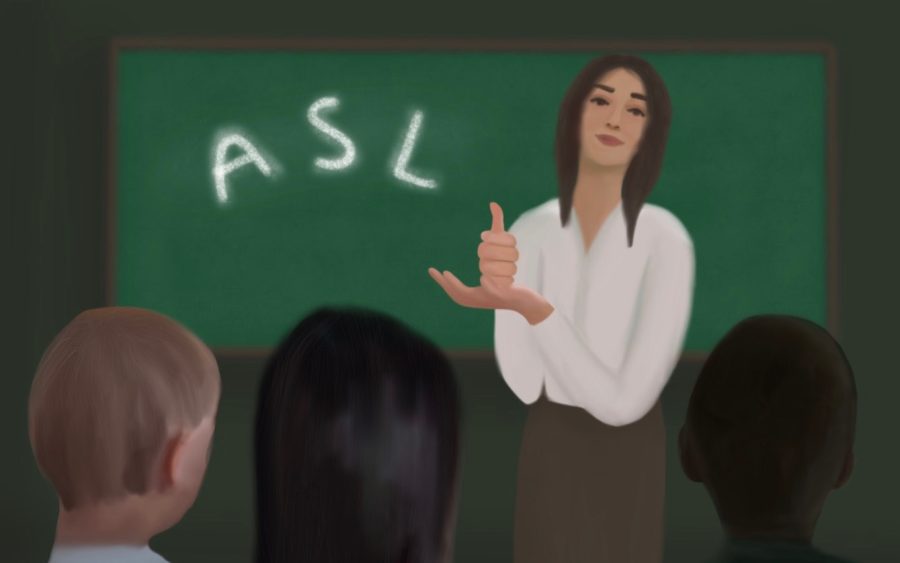A sign for change: Learning sign language increases accessibility and inclusivity
Why more schools like Harker should offer sign language as a course
“Learning sign language offers the same benefits as any spoken language such as advanced communication skills, increased memory span and improved academic performance.” In this illustration, the teacher is signing the word for “help” in American Sign Language.”
March 28, 2022
Moving a finger to your lips to shush others; giving someone a thumbs-up; wagging a finger in disapproval: all examples of sign language. From our childhood to now, we’ve relied on signs with actions such as counting on our fingers or waving with our hands to greet others. Unconsciously, we’ve started to use them every day.
Over the past years, I’ve seen my friends and people on social media learn American Sign Language (ASL) or encourage others to do so. Intrigued, I attempted to do the same over Thanksgiving break last year and mastered some basic signs through an online website. After just a couple of days, I knew how to sign numbers one through 10, how to ask if someone is hearing or deaf, greetings and more. But an issue arose when I returned to school after break: I’d forgotten most of what I had memorized as I lacked time to practice with school picking up again.
I wished I had an opportunity to learn this new language as part of my usual school curriculum — a possible reality for me if Harker offered ASL as a course.
Learning sign language offers the same benefits as any spoken language such as advanced communication skills, increased memory span and improved academic performance. Learning sign language also has additional advantages compared to other languages, as learners are more expressive, and sign language also fosters verbal communication development. The latter is especially prevalent in young children who haven’t learned a verbal language yet. Starting out with physical movement to convey emotion and thought proves useful when learning how to do the same with words.

Harker students themselves have expressed an interest in the language as according to Harker Aquila’s Instagram poll, out of 99 upper school students who responded, 73% stated that they would enroll in a sign language course at school even if it was just for a semester. The class itself could consist of a teacher educating students about various issues and topics regarding disabilities while also teaching them to sign ASL. California’s Antelope High School offers three different ASL classes, each more advanced than the previous one. The first level class, ASL 1, introduces students to the culture and issues of the deaf community and educates them on basic signs, comprehension and grammar. In the course description, it states that the goal of the class is to have students gain the ability to communicate and interact with the deaf community.
The use of sign language has been climbing with over half a million learners and users in the U.S. currently, and I’ve seen multiple uses of it over the past years as part of inclusivity and accessibility movements. For instance, I started seeing an ASL interpreter next to President Joe Biden at the beginning of last year during presidential conferences. Since then, a sign language interpreter has been present at all daily press briefings as a new effort by the Biden administration to disseminate information to all communities regardless of impairments.
Mask mandates due to the pandemic have taken a toll on the deaf or hard of hearing community since they can no longer rely on lip reading or taking note of facial expressions, a preferable method over sign language. Additionally, translators have moved to remote settings, creating difficulties for those hard of hearing to communicate with others. As a result, most have continued to use sign language, but not many hearing individuals know it. A U.S. National Library of Medicine (NLM) and National Institutes of Health (NIH) study found that the deaf community received less information about COVID-19 regulations and protocol than hearing people due to the challenges of communication.
These difficulties can be resolved by hearing aids and other technology designed with a similar purpose, but they’ve become increasingly expensive over the years with hearing aid prices soaring up to $5000. Only a fifth of people who need hearing aids actually own them, causing people to resort to sign language.

The surge in usage of sign language, difficulties arising for the hard of hearing community and the new demand for the language makes learning it even more beneficial. Memorizing and practicing the signs would allow us to interact with a whole other community and propagate the accessibility movement.
Harker Aquila has taken steps to serve our audience by implementing Aquila Audibles this year for people who prefer listening rather than reading and for individuals who need it. As a community, we can further increase accessibility by taking more actions like utilizing captions on Zoom during meetings.
Through learning ASL, we can listen to the opinions and thoughts of those who are perhaps unheard. Most of us will live in a much more diverse environment as we graduate high school and enter college. In a new atmosphere, we may even find ourselves using sign language to communicate with others — over 7.5 million people in the U.S. are deaf or have communication disorders. The language even counts towards California high school foreign language requirements, which state that all students must complete at least a year of foreign language, sign language included.
Sign language offers the benefits of verbal languages not only to learners but also to the deaf community. Around the globe and at Harker, people are moving forward with accessibility and inclusivity, and sign language achieves just that — it educates while opening doors.


















![“[Building nerf blasters] became this outlet of creativity for me that hasn't been matched by anything else. The process [of] making a build complete to your desire is such a painstakingly difficult process, but I've had to learn from [the skills needed from] soldering to proper painting. There's so many different options for everything, if you think about it, it exists. The best part is [that] if it doesn't exist, you can build it yourself," Ishaan Parate said.](https://harkeraquila.com/wp-content/uploads/2022/08/DSC_8149-900x604.jpg)




![“When I came into high school, I was ready to be a follower. But DECA was a game changer for me. It helped me overcome my fear of public speaking, and it's played such a major role in who I've become today. To be able to successfully lead a chapter of 150 students, an officer team and be one of the upperclassmen I once really admired is something I'm [really] proud of,” Anvitha Tummala ('21) said.](https://harkeraquila.com/wp-content/uploads/2021/07/Screen-Shot-2021-07-25-at-9.50.05-AM-900x594.png)







![“I think getting up in the morning and having a sense of purpose [is exciting]. I think without a certain amount of drive, life is kind of obsolete and mundane, and I think having that every single day is what makes each day unique and kind of makes life exciting,” Neymika Jain (12) said.](https://harkeraquila.com/wp-content/uploads/2017/06/Screen-Shot-2017-06-03-at-4.54.16-PM.png)








![“My slogan is ‘slow feet, don’t eat, and I’m hungry.’ You need to run fast to get where you are–you aren't going to get those championships if you aren't fast,” Angel Cervantes (12) said. “I want to do well in school on my tests and in track and win championships for my team. I live by that, [and] I can do that anywhere: in the classroom or on the field.”](https://harkeraquila.com/wp-content/uploads/2018/06/DSC5146-900x601.jpg)
![“[Volleyball has] taught me how to fall correctly, and another thing it taught is that you don’t have to be the best at something to be good at it. If you just hit the ball in a smart way, then it still scores points and you’re good at it. You could be a background player and still make a much bigger impact on the team than you would think,” Anya Gert (’20) said.](https://harkeraquila.com/wp-content/uploads/2020/06/AnnaGert_JinTuan_HoHPhotoEdited-600x900.jpeg)

![“I'm not nearly there yet, but [my confidence has] definitely been getting better since I was pretty shy and timid coming into Harker my freshman year. I know that there's a lot of people that are really confident in what they do, and I really admire them. Everyone's so driven and that has really pushed me to kind of try to find my own place in high school and be more confident,” Alyssa Huang (’20) said.](https://harkeraquila.com/wp-content/uploads/2020/06/AlyssaHuang_EmilyChen_HoHPhoto-900x749.jpeg)












